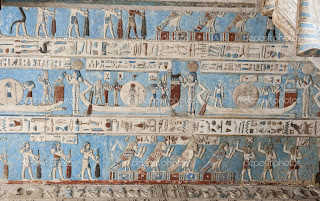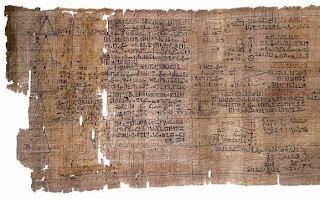In the sixth century BC, what three civilizations invaded Egypt? Persians, Greeks, and Romans
Post an example of the inside wall(s) of an Ancient Egyptian temple.
What was discovered on the inside of the temples?
Carved and painted images on every wall and surface
Scholars believe that Ancient Egyptians were inspired and influenced by which written language?
Cuneiform
What is the difference between logographic and alphabetic elements?
The term Hieroglyphic derived from what two Greek words?
Logographic-Visual symbols representing ideas or objects
Alphabetic-Represents more sounds and letters; hiero & glyphic
What is a scribe?
Anyone that could read and write, that documented the past
Who else was trained to read and write? Why?Military leaders, so they could communicated during battle
Priests in temples, so they could write out instrustiond for rituals
Post an example of hieroglyphics on papyrus.
What is papyrus and how was it made?
A substrate made from reeds native to Egypt; wet reeds are placed Criss-cross over each other, flattened and dried, than rubbed with flat stones until the surface is smooth
What is a substrate?The substance on which an enzyme acts
What were the Books of the Dead?they were scrolls for pharaohs that had instructions for the afterlife
How did Ancient Egyptian hieroglyphics become a forgotten language?
People stopped passing on how to read or write themPost an example of the Rosetta Stone
What is the Rosetta Stone? Where was it discovered?
A slab with the same inscription written in 3 languages; Rosetta, Egypt
What three languages are included on the stone?Egyptian Hieroglyphics, Demotic, Greek
Why couldn't the text on the Stone be deciphered?
A chunk of the stone was gone and none of the texts were complete
Who finally deciphered the text? What was his breakthrough?
Jean Francois Champollion; He was able to match some hieroglyphics to the Greek version of the name Egyptian Pharaoh Ramses
Why does the interpretation of the Rosetta Stone have such significance?
We know a lot more about the ancient Egyptians and their hieroglyphics



No comments:
Post a Comment